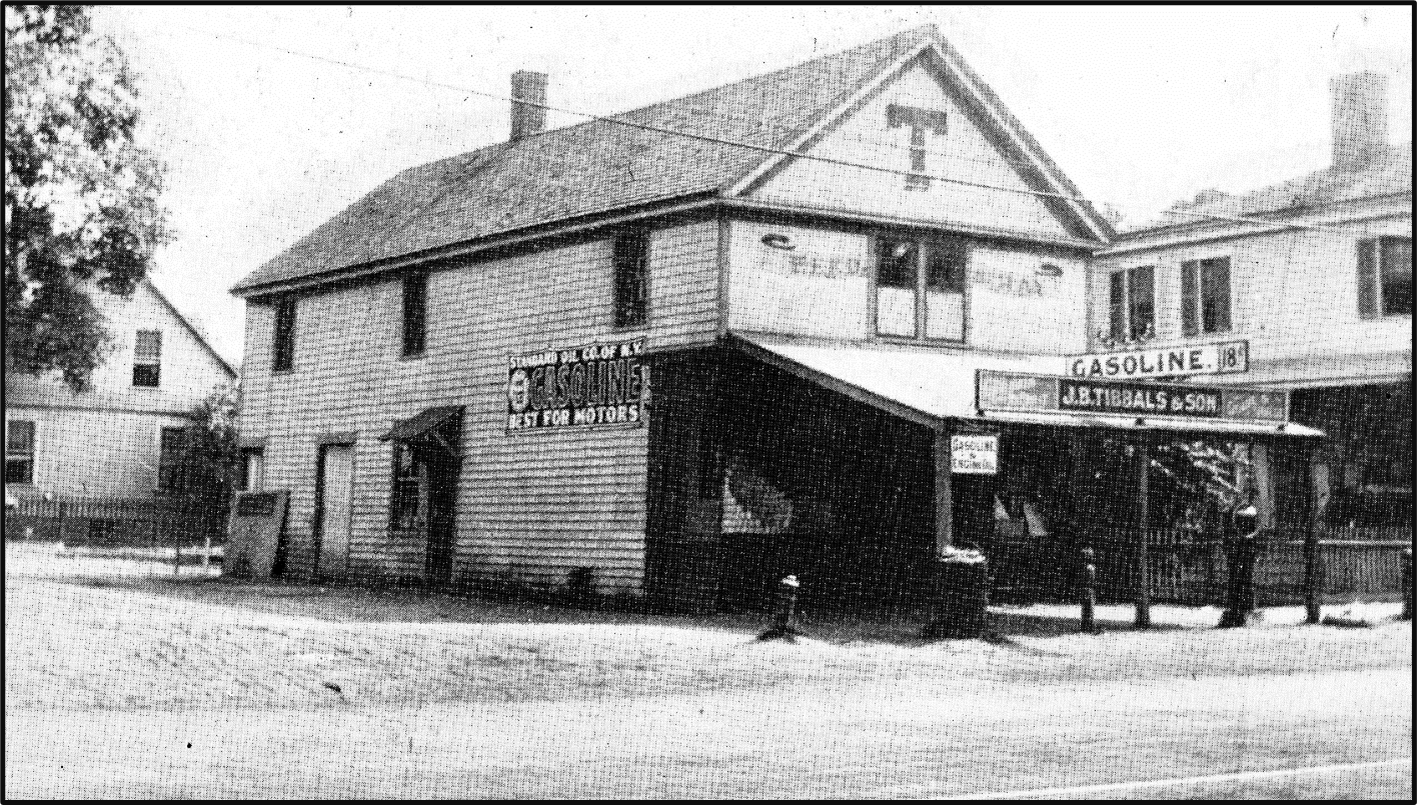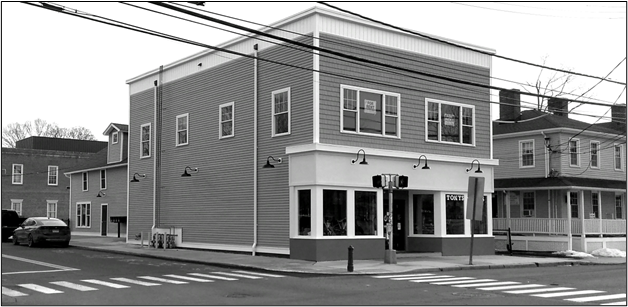By Marilyn May
Milford History

When there was a big “T” on this building, it was hard to miss that it was the J.B. Tibbals & Sons grocery and gasoline station. This building, constructed in 1828 on the corner of South Broad and High Streets, was extensively renovated in recent years. Photo courtesy of the Daniel E. Moger Photo Collection.
The original caption on photo of the building with a ‘T’ on it was, “The store of Messrs. Mark and George Tibbals at the corner of Broad and High streets was a grocery and like most stores, was a sort of club room for men in the evenings. Each store claimed its own particular coterie of gents who invariably gathered in their chosen places by the stove or upon a barrelhead.”
Today, instead of Tibbals’ store it’s Tony’s store. The store’s full name today is Tony’s Bikes & Sports. The name Tony’s has been used by the past three bicycle shop owners: Tony Arnold, Anthony Libretti and their longtime friend and current owner Mike Macisco. Macisco said he kept the name Tony’s because “Mike’s Bikes” sounded funny to him. The business was started 32 years ago, and Macisco has been running it now for 16 years.
During the height of the coronavirus pandemic, you could see a line of customers along South Broad Street, six feet apart, masked and waiting for a turn to go into the store, one customer at a time.
When someone comes into Tony’s and asks to talk to the boss, Macisco says, “You’re the boss. I work here for you. How can I help?” As in decades past, the same welcoming atmosphere is still in the building.
Macisco’s helpful attitude goes well beyond the store: “I do a lot with scouts, and I met a boy one time who had a lot of talent but no means to buy a bike, so I gave him one.” His passion for bike riding took him all the way to Cuba a few years ago when he packed up tools and bicycle parts and ran workshops there in which he showed people how to repair their bikes. Bicycles are especially important on the island, because today only 3 percent of the people own cars. And Macisco is still in touch with those he met there.
There is an intriguing piece of Milford history in the basement of the bike store today.
“There’s an old safe down here,” said Macisco, pushing away packing boxes to reveal a steel safe with a creaky door and a wooden interior. “There’s so much stuff in here. One of the old owners must have just left everything. Someday, I want to go through it all.”
The safe is a little time capsule of the years 1948-1949, when Fraser’s Market and Co-Op did business there. There are hand-written accounts totaling the day’s sales and copies of receipts given to customers and vendors. The safe is full of canceled checks and books of unused checks from the former Milford Trust Co.
In 2006, Donna and Larry Galbo bought the building and Donna said restoring it “was a labor of love” – apparently a lot of labor and a lot of love, not to mention a lot of money. The building was completely renovated from top to bottom.
The building needed a new roof and a modern sprinkler system. They had to redo the plumbing, electrical wiring and sewer system. The integrity of the whole structure, however, can be seen in the basement, where an original hefty, wooden beam runs the length of the cellar along with other beams extending to the walls and anchoring the floor above.
Donna Galbo was eager to learn more about the history of the building. There were few records, however, because much of what she was looking for, she was told, was destroyed in the infamous flood of 1982 when the Wepawaug River poured over its banks and right into City Hall’s basement where the oldest records were stored.
She was told the building was constructed in 1920, but recently found out it was actually built in 1828.
Undaunted, she kept digging into other archives and found that the entire top floor of the building was once a dress factory. The room has a 15-foot ceiling and had intricate moldings that she regrets she was not able to restore.
While doing historical research, some culled information reveals just hints, not provable facts. There were intriguing notices in the Morning Journal and Courier newspaper that may – or may not – be part of this building’s story. The Sept. 22, 1897 edition reported that “Mrs. Frank M. Brown has decided to go out of the dressmaking business.”
Is that the same dress shop mentioned above? In the Oct. 1, 1897 paper it was noted that “Mr. Frank M. Brown, the local bicycle dealer, will sell at public auction Saturday afternoon, Oct. 2, his entire stock of second hand bicycles, many of which are nearly new.”
If the dress shop information was about a business in the same building, did Mr. Brown run a bicycle shop in the late 19th century on the first floor of the building? Maybe. At any rate, he did not go out of business. The March 3, 1898 issue reported “Mr. Frank M. Brown, the local cycle dealer, has a pretty ‘Stormer,’ tandem on exhibition in his large show window.”
Along the High Street side, a one-floor addition was put on probably sometime in the early 1950s. One of the first tenants was Connie Moore’s Dance Studio. Many a little girl in Milford tapped across that floor or tiptoed around in ballet slippers, following the instructions of their beloved teacher “Miss Connie.”
Later, there was a barber shop there, and today there is a studio called “A-T Sangha Yoga,” where instructor Traci Weber wants to bring people together in community. (Sounds a little like what the old gents sitting around on barrel heads were doing long ago.)
Today, the second-floor space over Tony’s shop has been made into three apartments with those wonderful 15-foot ceilings.
Most old-time Milford residents know that the Tibbals’ name goes back to one of the first settlers, Sergeant Thomas Tibbals (1613-1703). The name is spelled Tibballs in some references, and later he was referred to as Capt. Thomas Tibbals by way of his service in the Connecticut Militia.
He was born in Great Hampden, Buckinghamshire, England and migrated to New England in the Puritan Great Migration of 1620-1640.
In 1637 while traveling along the Connecticut shoreline, Tibbals noticed that this area would be a good place for a settlement. It had a freshwater river, lush meadows, abundant seafood, dense forests, plenty of game and a fine harbor that led to Long Island Sound.
Meanwhile, in that same year, many of Milford’s founders were sailing from London to the already busy city of Boston. In 1638 they were in New Haven, where they stayed about a year. Once there, their much-admired leader, Rev. Peter Prudden, was called to preach for a time at a Wethersfield church that was without a pastor. Several Wethersfield families decided to follow Prudden and his original group, and all had their minds and futures set on founding a settlement of their own. That’s when Tibbals told them what he had seen here in what became Milford.
So in 1639 it was Tibbals who led about 54 families and their livestock the 11 miles from New Haven to Milford, traveling mostly by Indian trails that he had traversed many times. He is memorialized by inscriptions on Memorial Bridge.
The building at 108 Broad St. has served many purposes in its 194 years. Today it is restored, renewed and ready to take on the future.

The renovated Tibbals’ building as it looks today, with an addition in back that was also modernized. The front, ground-floor store is where Tony’s Bike Shop carries on business today. The cannon in cement on the corner can be seen in both photos. Photo courtesy of Marilyn May.
Marilyn May is a lifelong resident of Milford and is on the board of the Milford Historical Society.